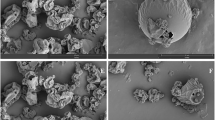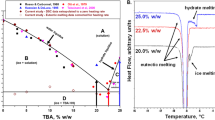Abstract
Purpose
The aim of this study is to determine the effects of saccharide-containing excipients on the surface composition of spray-dried protein formulations and their matrix heterogeneity.
Methods
Spray-dried formulations of myoglobin or bovine serum albumin (BSA) were prepared without excipient or with sucrose, trehalose, or dextrans. Samples were characterized by solid-state Fourier-transform infrared spectroscopy (ssFTIR), differential scanning calorimetry (DSC), size exclusion chromatography (SEC) and scanning electron microscopy (SEM). Protein surface coverage was determined by X-ray photoelectron spectroscopy (XPS), while conformational differences were determined by solid-state hydrogen/deuterium exchange with mass spectrometry (ssHDX-MS).
Results
Structural differences were exhibited with the inclusion of different excipients, with dextran formulations indicating perturbation of secondary structure. XPS indicated sucrose and trehalose reduced protein surface concentration better than dextran-containing formulations. Using ssHDX-MS, the amount of deuterium incorporation and populations present were the largest in the samples processed with dextrans. Linear correlation was found between protein surface coverage and ssHDX-MS peak area (R2 = 0.853) for all formulations with saccharide-containing excipients.
Conclusions
Lower molecular weight species of saccharides tend to enrich the particle surface and reduce protein concentration at the air-liquid interface, resulting in reduced population heterogeneity and improved physical stability, as identified by ssHDX-MS.










Similar content being viewed by others
References
Carpenter JF, Chang BS, Garzon-Rodriguez W, Randolph TW. Rational design of stable lyophilized protein formulations: theory and practice. In: Carpenter JF, Manning MC, editors. Rational Design of Stable Protein Formulations: theory and practice. Boston: Springer US; 2002. p. 109–33.
Langford A, Bhatnagar B, Walters R, Tchessalov S, Ohtake S. Drying technologies for biopharmaceutical applications: recent developments and future direction. Dry Technol. 2018;36(6):677–84.
Gaiani C, Mullet M, Arab-Tehrany E, Jacquot M, Perroud C, Renard A, et al. Milk proteins differentiation and competitive adsorption during spray-drying. Food Hydrocoll. 2011;25(5):983–90.
Kim EHJ, Chen XD, Pearce D. Surface composition of industrial spray-dried milk powders. 2. Effects of spray drying conditions on the surface composition. J Food Eng. 2009;94(2):169–81.
Maa Y-F, Prestrelski SJ. Biopharmaceutical powders particle formation and formulation considerations. Curr Pharm Biotechnol. 2000;1(3):283–302.
Lee G. Spray-drying of proteins. In: Carpenter JF, Manning MC, editors. Rational Design of Stable Protein Formulations: theory and practice. Boston: Springer US; 2002. p. 135–58.
White S, Bennett DB, Cheu S, Conley PW, Guzek DB, Gray S, et al. EXUBERA®: pharmaceutical development of a novel product for pulmonary delivery of insulin. Diabetes Technol Ther. 2005;7(6):896–906.
Abdul-Fattah AM, Kalonia DS, Pikal MJ. The challenge of drying method selection for protein pharmaceuticals: product quality implications. J Pharm Sci. 2007;96(8):1886–916.
Manning MC, Chou DK, Murphy BM, Payne RW, Katayama DS. Stability of protein pharmaceuticals: an update. Pharm Res. 2010;27(4):544–75.
Webb SD, Golledge SL, Cleland JL, Carpenter JF, Randolph TW. Surface adsorption of recombinant human interferon-γ in lyophilized and spray-lyophilized formulations. J Pharm Sci. 2002;91(6):1474–87.
Ameri M, Maa Y-F. Spray drying of biopharmaceuticals: stability and process considerations. Dry Technol. 2006;24(6):763–8.
Patapoff TW, Esue O. Polysorbate 20 prevents the precipitation of a monoclonal antibody during shear. Pharm Dev Technol. 2009;14(6):659–64.
Moussa EM, Wilson NE, Zhou QT, Singh SK, Nema S, Topp EM. Effects of drying process on an IgG1 monoclonal antibody using solid-state hydrogen deuterium exchange with mass spectrometric analysis (ssHDX-MS). Pharm Res. 2018;35(1):12.
Wilson NE, Topp EM, Zhou QT. Effects of drying method and excipient on structure and stability of protein solids using solid-state hydrogen/deuterium exchange mass spectrometry (ssHDX-MS). Int J Pharm. 2019;567:118470.
Moorthy BS, Iyer LK, Topp EM. Mass spectrometric approaches to study protein structure and interactions in lyophilized powders. J Vis Exp 2015(98):52503–52503.
Lueckel B, Helk B, Bodmer D, Leuenberger H. Effects of formulation and process variables on the aggregation of freeze-dried Interleukin-6 (IL-6) after Lyophilization and on storage. Pharm Dev Technol. 1998;3(3):337–46.
Tonnis WF, Mensink MA, de Jager A, van der Voort MK, Frijlink HW, Hinrichs WLJ. Size and molecular flexibility of sugars determine the storage stability of freeze-dried proteins. Mol Pharm. 2015;12(3):684–94.
Bhujbal SV, Zemlyanov DY, Cavallaro A, Mangal S, Taylor LS, Zhou QT. Qualitative and quantitative characterization of composition heterogeneity on the surface of spray dried amorphous solid dispersion particles by an advanced surface analysis platform with high surface sensitivity and superior spatial resolution. Mol Pharm. 2018;15(5):2045–53.
Adler M, Lee G. Stability and surface activity of lactate dehydrogenase in spray-dried trehalose. J Pharm Sci. 1999;88(2):199–208.
Lechuga-Ballesteros D, Charan C, Stults CLM, Stevenson CL, Miller DP, Vehring R, et al. Trileucine improves aerosol performance and stability of spray-dried powders for inhalation. J Pharm Sci. 2008;97(1):287–302.
Simperler A, Kornherr A, Chopra R, Bonnet PA, Jones W, Motherwell WDS, et al. Glass transition temperature of glucose, sucrose, and Trehalose: an experimental and in Silico study. J Phys Chem B. 2006;110(39):19678–84.
Larsen BS, Skytte J, Svagan AJ, Meng-Lund H, Grohganz H, Löbmann K. Using dextran of different molecular weights to achieve faster freeze-drying and improved storage stability of lactate dehydrogenase. Pharm Dev Technol. 2019;24(3):323–8.
Towns JK. Moisture content in proteins: its effects and measurement. J Chromatogr A. 1995;705(1):115–27.
Fu K, Griebenow K, Hsieh L, Klibanov AM, Robert L. FTIR characterization of the secondary structure of proteins encapsulated within PLGA microspheres. J Control Release. 1999;58(3):357–66.
Sinha S, Li Y, Williams TD, Topp EM. Protein conformation in amorphous solids by FTIR and by hydrogen/deuterium exchange with mass spectrometry. Biophys J. 2008;95(12):5951–61.
Barbosa LRS, Ortore MG, Spinozzi F, Mariani P, Bernstorff S, Itri R. The importance of protein-protein interactions on the pH-induced conformational changes of bovine serum albumin: a small-angle X-ray scattering study. Biophys J. 2010;98(1):147–57.
Sophocleous AM, Zhang J, Topp EM. Localized hydration in lyophilized myoglobin by hydrogen-deuterium exchange mass spectrometry. 1. Exchange mapping. Mol Pharm. 2012;9(4):718–26.
Heller MC, Carpenter JF, Randolph TW. Manipulation of Lyophilization-induced phase separation: implications for pharmaceutical proteins. Biotechnol Prog. 1997;13(5):590–6.
Maa Y-F, Costantino HR, Nguyen P-A, Hsu CC. The effect of operating and formulation variables on the morphology of spray-dried protein particles. Pharm Dev Technol. 1997;2(3):213–23.
Mensink MA, Nethercott MJ, Hinrichs WLJ, van der Voort MK, Frijlink HW, Munson EJ, et al. Influence of miscibility of protein-sugar Lyophilizates on their storage stability. AAPS J. 2016;18(5):1225–32.
Vehring R. Pharmaceutical particle engineering via spray drying. Pharm Res. 2008;25(5):999–1022.
Acknowledgments and Disclosures
This study was partially supported by the National Institute of Allergy and Infectious Diseases of the National Institutes of Health under Award Number R01AI132681 and R01AI146160. The content is solely the responsibility of the authors and does not necessarily represent the official views of the National Institutes of Health.
Author information
Authors and Affiliations
Corresponding authors
Additional information
Publisher’s Note
Springer Nature remains neutral with regard to jurisdictional claims in published maps and institutional affiliations.
Electronic supplementary material
ESM 1
(DOCX 14 kb)
Rights and permissions
About this article
Cite this article
Wilson, N.E., Mutukuri, T.T., Zemlyanov, D.Y. et al. Surface Composition and Formulation Heterogeneity of Protein Solids Produced by Spray Drying. Pharm Res 37, 14 (2020). https://doi.org/10.1007/s11095-019-2738-9
Received:
Accepted:
Published:
DOI: https://doi.org/10.1007/s11095-019-2738-9




